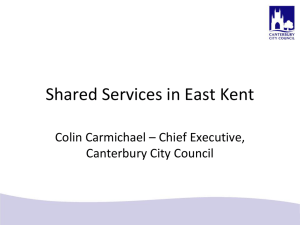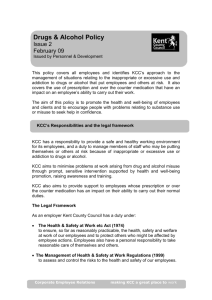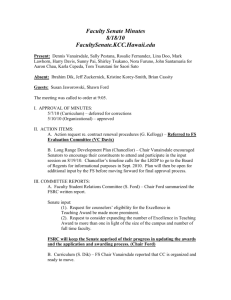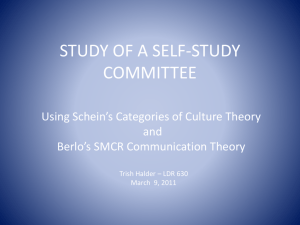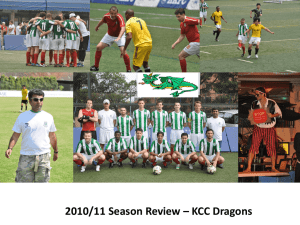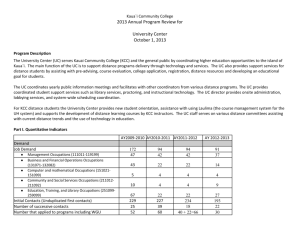Document 10950737
advertisement
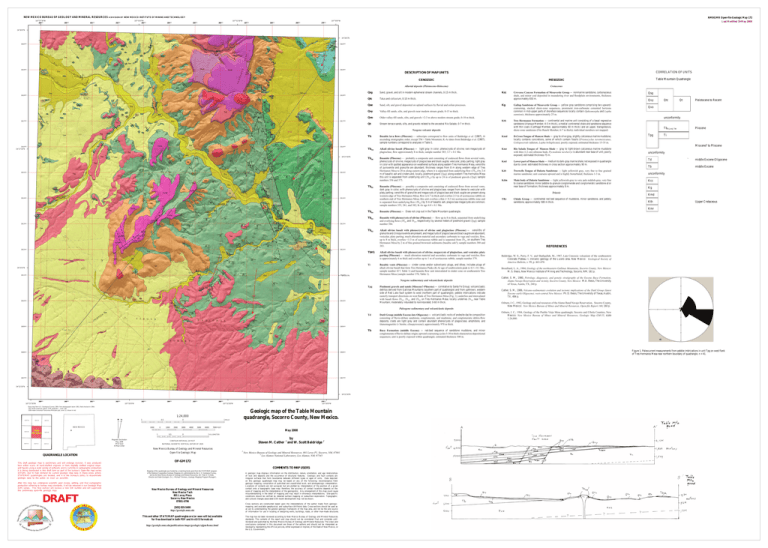
NEW MEXICO BUREAU OF GEOLOGY AND MINERAL RESOURCES A DIVISION OF NEW MEXICO INSTITUTE OF MINING AND TECHNOLOGY 107°37'30"W NMBGMR Open-file Geologic Map 172 107°35'0"W 259000 260000 261000 262000 107°32'30"W 263000 264000 265000 107°30'0"W 266000 267000 268000 269000 Last Modified 19 May 2008 270000 34°30'0"N TbH5 Kcc Kcc Kcc Qvy 2 Kcc Kcc 11 Kcc Kcc Kcc Kcc Kcc 12 3816000 2 9 Kcc Tpg 2 Kcc Kcc 6 Qtc 5 6 4 6 Qtc 4 Tpg Qtc 4 9 Kcc 7 3 6 7 Qtc Qtc Qtc Qvo 6 Qtc Qvo Qvo 4 Qvo 2 6 Qtc 7 4 Qt Qvy Kmd KgKmd Kg 4 3 Kth Basanite (Pliocene) — Does not crop out in the Table Mountain quadrangle. TbH3 Basanite with phenocrysts of olivine (Pliocene) — flow up to 8 m thick, separated from underlying and overlying flows (TbH2 and TbH5, respectively) by several meters of piedmont gravel (Tpg); sample number 384. TbH2 Alkali olivine basalt with phenocrysts of olivine and plagioclase (Pliocene) — xenoliths of granulite and clinopyroxenite are present, and megacrysts of plagioclase and black augite are abundant; vesicular, platy parting; much alteration material and secondary carbonate in vugs and vesicles; flow, up to 8 m thick, overlies <1-3 m of scoriaceous rubble and is separated from TbH1 on southern Tres Hermanos Mesa by 2 m of fine grained brownish sediments (basaltic ash?); sample numbers 380 and 383. 3813000 Qvy 6 Kcc 7 4 7 Kg Qvo TbH1 5 Qvy Qtc 34°25'0"N Kcc Qvy 2 Kcc Qvy 4 Kcc 5 5 9 6 14 Ti 3811000 Ti 7 4 Qvy 4 Tpg 000 3811 34°25'0"N 3 8 3810000 Qsg Qae Tpg Qvo Tpg 4 2 Qsg Qtc 3 10 Qtc Qae 3810000 Tpg Kcc Qvy Kcc 11 Tpg Tpg 4 Kcc Kcc Tpg Qae Kcc 999 14 Kcc Tpg 5 Tpg Kcc Tpg 7 Qae 7 Tpg 3808000 Tpg Tb 8 Tb Td Tb Tpg Tb Tpg Tb Tb 6 Tpg 3807000 Tsp Tb 3807000 9 Td 11 34°22'30"N 34°22'30"N 259000 260000 261000 107°37'30"W 262000 263000 264000 265000 266000 107°35'0"W 267000 1 34107-E4 NEW MEXICO 34107-D6 34107-C6 Table 34107-D5 Mountain 34107-C5 0.5 1000 0 0 1000 2000 3000 1 MILE 4000 5000 6000 7000 FEET May 2008 1 QUADRANGLE LOCATION This draft geologic map is preliminary and will undergo revision. It was produced from either scans of hand-drafted originals or from digitally drafted original maps and figures using a wide variety of software, and is currently in cartographic production. It is being distributed in this draft form as part of the bureau's Open-file map series (OFGM), due to high demand for current geologic map data in these areas where STATEMAP quadrangles are located, and it is the bureau's policy to disseminate geologic data to the public as soon as possible. After this map has undergone scientific peer review, editing, and final cartographic production adhering to bureau map standards, it will be released in our Geologic Map (GM) series. This final version will receive a new GM number and will supercede this preliminary open-file geologic map. DRAFT 270000 Geologic map of the Table Mountain quadrangle, Socorro County, New Mexico. 34107-D4 34107-C4 269000 107°30'0"W 1:24,000 34107-E5 268000 107°32'30"W Base map from U.S. Geological Survey 1964, from photographs taken 1963, field checked in 1964. 1927 North American datum, UTM projection -- zone 13N 1000-meter Universal Transverse Mercator grid, zone 13, shown in red 34107-E6 Magnetic Declination May, 2008 9º 52' East At Map Center 0.5 0 1 KILOMETER by Steven M. Cather and W. Scott Baldridge 1 CONTOUR INTERVAL 20 FEET NATIONAL GEODETIC VERTICAL DATUM OF 1929 New Mexico Bureau of Geology and Mineral Resources Open-file Geologic Map 1 2 New Mexico Bureau of Geology and Mineral Resources, 801 Leroy Pl., Socorro, NM, 87801 2 Los Alamos National Laboratory, Los Alamos, NM, 87545 OF-GM 172 COMMENTS TO MAP USERS Mapping of this quadrangle was funded by a matching-funds grant from the STATEMAP program of the National Cooperative Geologic Mapping Act, administered by the U. S. Geological Survey, and by the New Mexico Bureau of Geology and Mineral Resources, (Dr. Peter A. Scholle, Director and State Geologist , Dr. J. Michael Timmons, Geologic Mapping Program Manager ). New Mexico Bureau of Geology and Mineral Resources New Mexico Tech 801 Leroy Place Socorro, New Mexico 87801-4796 [505] 835-5490 http://geoinfo.nmt.edu This and other STATEMAP quadrangles are (or soon will be) available for free download in both PDF and ArcGIS formats at: http://geoinfo.nmt.edu/publications/maps/geologic/ofgm/home.html Kdt Twowells Tongue of Dakota Sandstone — light yellowish gray, very fine to fine grained marine sandstone; unit coarsens upward and is highly bioturbated; thickness 1-3 m. Kdm Main body of Dakota Sandstone — light yellowish-gray to very pale reddish-gray, very fine to coarse sandstone; minor pebble-to-granule conglomerate and conglomeratic sandstone at or near base of formation; thickness approximately 8 m. Triassic TRc Chinle Group — continental red bed sequence of mudstone, minor sandstone, and pebbly sandstone, approximately 580 m thick. Qtc Qt Pleistocene to Recent Qvo unconformity Pliocene TbH1-H6, TM Tpg Ti Miocene? to Pliocene unconformity Td Tb ` middle Eocene-Oligocene middle Eocene unconformity Kcc Kg Kmd Kth Upper Cretaceous Kmr REFERENCES Baldridge, W. S., Perry, F. V., and Shafiqullah, M., 1987, Late Cenozoic volcanism of the southeastern Colorado Plateau; I, Volcanic geology of the Lucero area, New Mexico: Geological Society of America Bulletin, v. 99, p. 463-470. Broulliard, L. A., 1984, Geology of the northeastern Gallinas Mountains, Socorro County, New Mexico: M. S. thesis, New Mexico Institute of Mining and Technology, Socorro, NM, 161 p. Cather, S. M., 1980, Petrology, diagenesis, and genetic stratigraphy of the Eocene Baca Formation, Alamo Navajo Reservation and vicinity, Socorro County, New Mexico: M.A. thesis, The University of Texas, Austin, TX, 240 p. Cather, S. M., 1986, Volcano-sedimentary evolution and tectonic implications of the Datil Group (latest Eocene–early Oligocene), west-central New Mexico: Ph. D. thesis, The University of Texas, Austin, TX, 484 p. Osburn, J. C., 1982, Geology and coal resources of the Alamo Band Navajo Reservation, Socorro County, New Mexico: New Mexico Bureau of Mines and Mineral Resources, Open-file Report 160, 160 p. Tb Baca Formation (middle Eocene) — red-bed sequence of sandstone mudstone, and minor conglomerate of fluvio-deltaic origin; upward-coarsening cycles 5-30 m thick characterize depositional sequences; unit is poorly exposed within quadrangle; estimated thickness 300 m. Osburn, J. C., 1984, Geology of the Pueblo Viejo Mesa quadrangle, Socorro and Cibola Counties, New Mexico: New Mexico Bureau of Mines and Mineral Resources, Geologic Map GM-55, scale 1:24,000. 5 Tpg 3808000 Lower part of Mancos Shale — medium to dark-gray marine shale; not exposed in quadrangle due to cover; estimated thickness in cross section approximately 90 m. Qvy 3809000 4 3 Tpg Datil Group (middle Eocene-late Oligocene) — volcaniclastic rocks of andesite-dacite composition consisting of fluvio-deltaic sandstone, conglomerate, and mudstone, and conglomeratic debris-flow deposits; clasts are light gray and contain abundant phenocrysts of plagioclase, amphibole, and titanomagnetite (± biotite, clinopyroxene); approximately 970 m thick. 4 9 3809000 Piedmont gravels and sands (Miocene?-Pliocene) — correlative to Santa Fe Group; volcaniclastic detritus derived from Gallinas Mountains (southern part of quadrangle) and from upthrown, western side of Red Lake fault system to west (northern part of quadrangle); pebble imbrications indicate easterly transport directions on west flank of Tres Hermanos Mesa (Fig. 1); underlies and intercalated with basalt flows TbH2, TbH3, and TbH5 on Tres Hermanos Mesa; locally underlies TbTM near Table Mountain; moderately indurated to nonindurated; 0-60 m thick. Td 6 Tpg 5 4 Rio Salado Tongue of Mancos Shale — gray to light-brown calcareous marine mudstone with thin (1-2 cm) siltstone beds; Pycnodonte newberryi is abundant near base of unit; poorly exposed; estimated thickness 75 m. Qsg Paleogene sedimentary and volcaniclastic deposits 9 Tpg 2 Qae Basaltic vents (Pliocene) — cinder cones and/or subvolcanic plugs, and dikes; includes plugs of alkali olivine basalt that form Tres Hermanos Peaks (K-Ar age of southwestern peak is 4.3 ± 0.1 Ma.; sample number 417, Table 1) and basanite flow unit intercalated in cinder cone on southeastern Tres Hermanos Mesa (sample number 378, Table 1). Neogene sedimentary and volcaniclastic deposits 12 Tpg Alkali olivine basalt with phenocrysts of olivine, megacrysts of plagioclase, and vesicular, platy parting (Pliocene) — much alteration material and secondary carbonate in vugs and vesicles; flow is approximately 6 m thick and overlies up to 1 m of scoriaceous rubble; sample number 379. 9 4 5 Qvy TbTM Kml D-Cross Tongue of Mancos Shale — gray to olive gray, slightly calcareous marine mudstone; locally contains concretions, some of which contain fossils (Prionocyclus novimexicanus, Coilopocerals inflatum, Lopha bellaplicata); poorly exposed; estimated thickness 15-35 m. Table Mountain Quadrangle 3812000 5 Qvy Qvy Qae Qt 5 Kcc Kg 6 7 22 4 Kcc 6 Qvo 11 3812000 Qvo 11 7 10 3 Qvo TbTM TbTM Basanite (Pliocene) — possibly a composite unit consisting of coalesced flows from several vents, dark gray in color, with phenocrysts of olivine and plagioclase; ranges from dense to vesicular with platy parting; xenoliths of granulite and megacrysts of plagioclase and black augite are present along western edge of Tres Hermanos Mesa; flow is 6-7 m thick and overlies 2-3 m of scoriaceous rubble on southern end of Tres Hermanos Mesa; this unit overlies a thin (< 0.3 m) scoriaceous rubble zone and is separated from underlying flow (TbH2) by 5 m of basaltic ash, plagioclase megacrysts are common; sample numbers 355, 381, and 382; K-Ar age 4.0 ± 0.1 Ma. TbH4 Tpg 5 TbTM TbTM Kmd Kcc Qvy Kg Qvy Kcc Kcc 3 Tpg Qae Kg Kg Qvy Kmd Kg 4 Qae TbTM Kmd Kg Kcc 10 Qtc Kmd Qt 6 Qtc 3813000 Kgo Qvy Qvo 2 4 4 TbTM Basanite (Pliocene) — probably a composite unit consisting of coalesced flows from several vents, phenocrysts of olivine; megacrysts of plagioclase and black augite; vesicular, platy parting, light gray in color with spotted appearance on weathered surfaces along eastern Tres Hermanos Mesa, xenoliths of pyroxenite and granulite are abundant; thickness ranges from 8 m along western edge of Tres Hermanos Mesa to 20 m along eastern edge, where it is separated from underlying flow (TbH5) by 2-4 m of basaltic ash and cinders and, locally, piedmont gravel (Tpg); along western Tres Hermanos Mesa this unit is separated from underlying unit (TbH5) by up to 24 m of piedmont gravels (Tpg); sample numbers 356 and 375. 3814000 4 Kcc 7 3 TbTM TbH6 TbH5 Kg 6 Kcc Tpg Tpg Kmd Qvy Qtc Kmr 2 Kmd Kg 4 0 Alkali olivine basalt (Pliocene) — light gray in color; phenocrysts of olivine; rare megacrysts of plagioclase, flow approximately 8 m thick; sample number 385; 3.7 ± 0.1 Ma. 3815000 6 5 4 Kcc Kcc1 Kg 5 Qt Qtc 14 Kcc TbTM Qt 5 Tpg Qtc TbTM 7 Tpg 3814000 Qvo Qt Qt Qae Qvy Qtc 4 4 Qt 9 2 Tpg Kcc Tres Hermanos Formation — continental and marine unit consisting of a basal regressive sandstone (Atarque Member, 4-5 m thick), a medial continental shale and sandstone sequence with thin coals (Carthage Member, approximately 60 m thick) and an upper, transgressive, shore-zone sandstone (Fite Ranch Member, 6-7 m thick); individual members not mapped. Qvy Qvy Qtc Kth TbTM Kth Qtc Tpg Gallup Sandstone of Mesaverde Group — yellow gray sandstone comprising two upwardcoarsening, stacked shore-zone sequences, prominent iron-carbonate cemented horizons common in mid-upper parts of shoreface sequences locally contain Ophiomorpha and Lopha sannionis; thickness approximately 25 m. Kmd 4 9 4 Qvy 3816000 34°27'30"N 10 2 5 3 5 Crevasse Canyon Formation of Mesaverde Group — nonmarine sandstone, carbonaceous shale, and minor coal deposited in meandering river and floodplain environments, thickness approximately 650 m. Kg Basaltic lava flows (Pliocene) — subscripts correspond to flow units of Baldridge et al. (1987), in ascending stratigraphic order, except TM = Table Mountain; K-Ar dates from Baldridge et al. (1987); sample numbers correspond to analyses in Table 1. Tb 6 4 Kcc Neogene volcanic deposits 5 5 4 Qtc Kmr Kmr Ti Qae 5 9 Kmr Kth 6 Qvy Tpg 3815000 12 Qtc 6 4 Kcc Ti Ti Tpg Kcc 5 Kcc 6 Kmr 16 11 12 8 Qae TbTM 34°27'30"N Stream terrace sands, silts, and gravels related to the ancestral Rio Salado; 0-7 m thick. Kth 2 7 Kcc 4 Qt 3817000 4 Qvy Kcc Older valley-fill sands, silts, and gravels >2-3 m above modern stream grade, 0-10 m thick. 9 Tpg Qae Kcc Qsg Kcc Kcc Qvo Kmr 28 999 14 6 TbH1 Qtc Tpg 2 Kcc Qtc Kcc Qt 12 Kcc Valley-fill sands, silts, and gravels near modern stream grade, 0-15 m thick. 14 3817000 Qt Qt Qvy 11 7 Kcc Kcc Sand, silt, and gravel deposited on upland surfaces by fluvial and eolian processes. 11 Qt Tpg Kcc Qae 3 Kcc Qae Tpg Tpg Kcc 14 2 Kcc Talus and colluvium, 0-10 m thick. 7 Kcc Cretaceous Qtc Kth Kcc 3 Kcc Kcc Kcc Kcc Alluvial deposits (Pleistocene-Holocene) 3818000 4 Qvy MESOZOIC Sand, gravel, and silt in modern ephemeral stream channels, 0-15 m thick. 24 Kg Qtc CENOZOIC Qsg Qvy 2 Qt 999 Qtc Kmr QtcKdt Ti Kcc 52 Ti Qt 2 Kcc Kcc Kcc TbH2 Qt Qt Qt Kcc Qtc Kdt 68 12 28 Qvy 3818000 Kcc 3 Kcc Tpg TbH5 Kdm Kdt Kdt CORRELATION OF UNITS DESCRIPTION OF MAP UNITS Kdt Kcc TbH2 Kcc Kcc 3819000 42 5 Kcc Kcc Kcc TbH6 Qtc 2 5 5 TbH5 3 Kcc Kcc Kcc Kcc Kcc Qvy 3 Kcc Qt 4 Kcc 2 Qt 3819000 Kmr @c 1 Kcc Qae Tpg Kdm Kcc Qtc 6 Kcc Qtc Kcc Tpg 5 Qvy Qtc TbH3 Kcc Kcc 2 Kcc Qae 9 Kcc Kcc 5 Qsg Kcc TbH3 5 Kcc Tpg TbH2 Tpg Kcc 3820000 4 9 Kcc Kdm @c Kdm Kdm Kdm @c 10 Kcc Kcc Kcc @c 8 999 Kdm 13 3 7 34°30'0"N Kcc Kcc 16 Kcc Kcc Kcc 7 7 Qvy Kcc Kcc Tpg 10 Tpg 5 Qvy Qsg 3820000 Kcc Tpg A geologic map displays information on the distribution, nature, orientation, and age relationships of rock and deposits and the occurrence of structural features. Geologic and fault contacts are irregular surfaces that form boundaries between different types or ages of units. Data depicted on this geologic quadrangle map may be based on any of the following: reconnaissance field geologic mapping, compilation of published and unpublished work, and photogeologic interpretation. Locations of contacts are not surveyed, but are plotted by interpretation of the position of a given contact onto a topographic base map; therefore, the accuracy of contact locations depends on the scale of mapping and the interpretation of the geologist(s). Any enlargement of this map could cause misunderstanding in the detail of mapping and may result in erroneous interpretations. Site-specific conditions should be verified by detailed surface mapping or subsurface exploration. Topographic and cultural changes associated with recent development may not be shown. Cross sections are constructed based upon the interpretations of the author made from geologic mapping, and available geophysical, and subsurface (drillhole) data. Cross-sections should be used as an aid to understanding the general geologic framework of the map area, and not be the sole source of information for use in locating or designing wells, buildings, roads, or other man-made structures. The map has not been reviewed according to New Mexico Bureau of Geology and Mineral Resources standards. The contents of the report and map should not be considered final and complete until reviewed and published by the New Mexico Bureau of Geology and Mineral Resources. The views and conclusions contained in this document are those of the authors and should not be interpreted as necessarily representing the official policies, either expressed or implied, of the State of New Mexico, or the U.S. Government. Figure 1. Paleocurrent measurements from pebble imbrications in unit Tpg on west flank of Tres Hermanos Mesa near northern boundary of quadrangle. n = 41.
